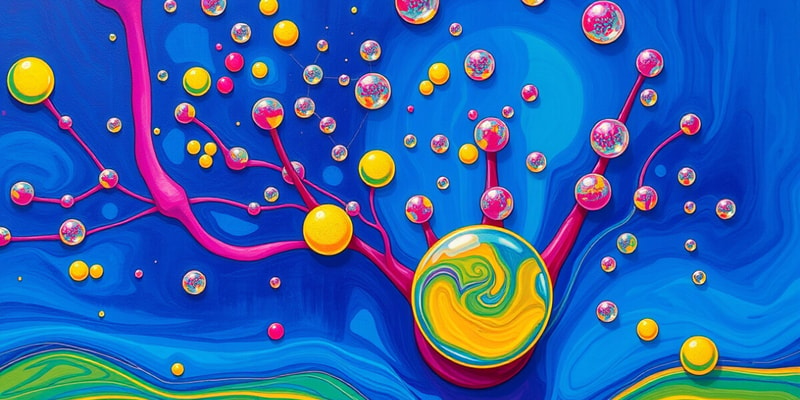Questions and Answers
What causes water to move up a tube when in contact with the tube's surface?
Which property of water allows the water strider to stay afloat?
What is the role of hydrogen bonding in water's properties?
What occurs at the top surface of water in a tube?
Signup and view all the answers
Which of the following best describes the pH scale?
Signup and view all the answers
What is the pH of a neutral solution?
Signup and view all the answers
If a solution has a high concentration of H+ ions, what type of solution is it?
Signup and view all the answers
How is pH related to the concentration of H+ ions in a solution?
Signup and view all the answers
Given that pure water has equal concentrations of H+ and OH- ions, what is their concentration in moles/liter?
Signup and view all the answers
What pH range corresponds to strong bases?
Signup and view all the answers
Study Notes
Properties of Water
- Water molecules exhibit cohesion, allowing them to stick together and form droplets.
- Adhesion enables water to be attracted to surfaces, such as glass, creating a meniscus effect at the water's surface.
- Water's unique properties contribute to various phenomena observed in nature, such as insects walking on water (e.g., water striders) and the ability of certain lizards to move on water's surface.
pH, Acids, Bases, and Buffers
- pH scales measure the concentration of hydrogen ions (H+) in a solution, using the formula pH = -log[H+].
- A neutral solution has a pH of 7; acidic solutions have pH < 7, while basic (alkaline) solutions have pH > 7.
- Water dissociates into equal amounts of H+ and hydroxide ions (OH-), both present at a concentration of (1 \times 10^{-7}) moles/liter in pure water.
- Acids increase the concentration of H+ ions in solutions, while bases increase the concentration of OH- ions.
Atoms and Elements
- Elements are substances that cannot be broken down into smaller units and are represented by chemical symbols (e.g., C for carbon, O for oxygen).
- The four most abundant elements in living organisms are carbon (C), oxygen (O), hydrogen (H), and nitrogen (N).
- Atomic structure consists of protons and neutrons located in the nucleus, with electrons orbiting in the outer regions.
Sub-Atomic Particles
- Protons have a positive charge, neutrons are neutral, and electrons have a negative charge.
- Mass number refers to the total number of protons and neutrons in an atom, while atomic weight is the average mass of all naturally occurring isotopes.
- Carbon has an atomic number of six and stable isotopes with mass numbers of 12 and 13, with an atomic weight of approximately 12.11.
Buffers in Biological Systems
- The bicarbonate buffer system regulates pH in human blood by balancing carbonic acid (H2CO3) and bicarbonate ions (HCO3-).
- The equilibrium of the bicarbonate system shifts depending on the pH level: if pH drops, the reaction shifts to the left, producing more H2CO3 to neutralize excess H+.
Studying That Suits You
Use AI to generate personalized quizzes and flashcards to suit your learning preferences.
Description
This quiz explores the phenomenon of capillary action, explaining how water movement in tubes is influenced by molecular attraction to surfaces. It also discusses the formation of a meniscus at the liquid's surface. Test your understanding of these concepts!




